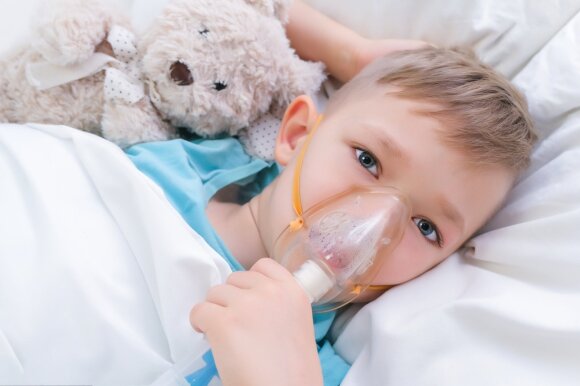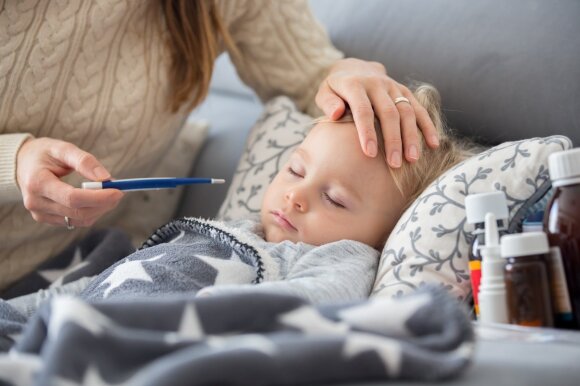
[ad_1]
The child was isolated since December 18 due to a risky contact. December 23 COVID-19 has been approved for the child. When will the child be considered healthy?
The extent to which an infected child needs to be isolated, as well as when it will be considered healthy, is decided by the treating physician, not the NVSC specialists. Generally, if a person has a mild or asymptomatic form, they will be considered healthy 10 days after the onset of symptoms or, in the case of asymptomatic, 10 days after the date of collection of a nasopharyngeal and pharyngeal smear that was detected by PCR.
However, each case is individual and is decided by the treating physician and not the NVSC specialists.
So when does NVSC decide on isolation?
NVSC specialists decide on isolation in cases where it is necessary to isolate uninfected but exposed people. For example, family members of an infected child, classmates who had a risky contact.
GPs do not address the isolation of people at risk.
Who needs to be isolated in case of a child on December 23. confirmed COVID-19 disease?
Isolation is required for 14 days for all those who have had a high-risk exposure, that is, they have been in contact for more than 15 minutes. at a distance of less than 2 m, you have had direct contact with your body fluids, you have had direct physical contact (such as hand pressure). The days when a person is dangerous (i.e. platinum virus) and when exposure can be considered high risk are calculated as follows:
If the person has symptoms, 72 hours. until the onset of symptoms and 10 days after the onset of symptoms.
If there are no symptoms, 72 hours. before taking a positive smear and 10 days after taking the smear.

The kid is sick
So if my child had symptoms on December 21, when should I isolate myself?
Isolation will be calculated as of December 21. until January 3. inclusive.
What if the child had symptoms on December 21, but the child is 6 years old and cannot take care of himself?
In this case, one of the parents must care for the infected child. This means that one of the parents lives in the same room with the infected person, so the father, mother or guardian is in contact with the infected child at all times.
For this reason, the 14-day isolation for one of the parents who is permanently with the child begins to run from the date on which the end of the child’s infectious period is evaluated. The last contact is considered to be the tenth day of the illness, which is estimated to be the last day of the contagious period.
Consequently, in this case, the isolation of one of the parents will be calculated according to the formula 10 + 13, that is, from December 21. Until 11 January. inclusive.
Does this mean that different terms of isolation apply to one parent caring for the child who is unable to care for himself and the other to a different term of isolation?
Yes. Because one of the parents will be in constant contact with the infected child, he is subject to the condition that he isolate himself with the child for up to 10 days of his illness and another 13 days afterward.
The other parent must be in isolation, so isolation will be calculated for him or her from the last day of contact, usually the day the test result is known.
This means that only one parent should be subjected to a longer period of isolation, not both?
Yes, one parent must care for the infected child, the other must isolate himself and be subject to a 14-day isolation period from the last contact.
How do you isolate if an infected single parent or guardian has to care for a sick child and there are no other people to care for the child?
In this case, the isolation of a child living with an infected person will be calculated according to the formula 10 + 13, that is, the child is isolated for up to 10 days of illness from the sick father, mother or guardian and for another 13 days later.

The kid is sick
Can the 10 + 13 isolation form be applied if one parent is sick and the other is healthy and can take care of the children?
You can not. In this case, if there are healthy people who can take care of the children, this should be done.
And as in this case, if a child became ill at home on December 18, the infection was confirmed on December 21, all other members of the family were isolated, but on December 23. Did the second child get sick?
The person must isolate himself after each risk contact with an infected coronavirus infection. Thus, in this case, the isolation period will be recalculated for family members who have had a risk contact with the second infected child, that is, when the last day of exposure was evaluated and the period will be recalculated. 14 day period.
This means that if the parents had contact with the child on December 23, when the symptoms occurred, the isolation will be recalculated for them until January 5. even, despite the fact that the isolation had to end earlier due to contact with the first child.
The exception is only for those who have been infected with COVID-19 themselves; They don’t need to be in isolation for three months after getting sick, even if they are at high risk.
Can high-risk exposure shorten isolation?
The possibility of shortening the isolation time is offered only for certain groups of people, i.e. doctors, civil servants, senior state officials (https://nvsc.lrv.lt/lt/visuomenei/nvsc.lrv.lt/sutrumpinti) . All others are valid for 14 days. isolation period, so there is no possibility to shorten the isolation time.
Is it possible to change the location of the insulation?
Is allowed. An isolated person must apply to the NVSC and obtain permission to go to another place of isolation if the person has to change it for any reason (the permit is only issued to go to a place of isolation). This must be done on the NVSC website https://nvsc.lrv.lt/leidimas.
It is strictly forbidden to use the information published by DELFI on other websites, in the media or elsewhere, or to distribute our material in any way without consent, and if consent has been obtained, it is necessary to indicate DELFI as the source .
[ad_2]